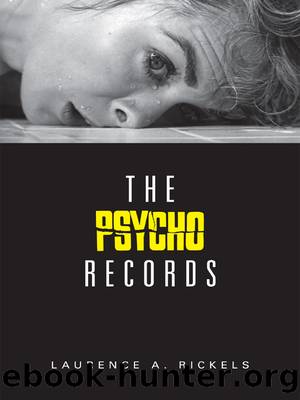The Psycho Records by Laurence A. Rickels

Author:Laurence A. Rickels
Language: eng
Format: epub
Tags: PER004030, Performing Arts/Film & Video/History & Criticism, PER004020, Performing Arts/Film & Video/Guides & Reviews
Publisher: Columbia University Press
Published: 2016-09-06T00:00:00+00:00
2
That mummy horror has no history (even the exploitation of King Tutâs curse was a long time coming) is owed to the truth its name cannot conceal: look at Abbott and Costello Meet the Mummy (1955) to appreciate what cannot be hidden, only denied or laughed off. We must go back to the very beginning of Hollywood horror to discover the story for which Karl Freundâs The Mummy (1932) was the sequel adaptation.
Gaston Lerouxâs Le Fantôme de lâOpéra explored the ghostly limits of the sensorium by following a phantom âVoiceâ and placing the work or âoperaâ of mourning in the foreground of its tale of haunting. The first film adaptation, Rupert Julianâs The Phantom of the Opera (1925), can be watched, after the fact, as the premiere articulation of psycho horror. Toward the close of the Psycho Effect two or three remakes of the story fit this range of recoil. In addition to The Phantom of the Opera by the slasher genreâs European correspondent Dario Argento in 1998, there was, eight years earlier, Phantom of the Opera: The Motion Picture, starring Robert Englund aka Freddy Krueger.
The Faust story, which plays in Gounodâs version on stage in the background of the phantomâs intrigues, enters the slasher phantomâs history in 1990. This phantom sold his soul to the Devil in exchange for the ability to break through to masterpiece music and take home the love of his audiences. He asks for renewal of life. But what he forgets to ask for is what he gets (superego-style): the life he wanted to control now hangs from his person as degenerative loss of face. He can save face, the face-to-face, only for the brief duration that lies between each death maskâs perfection and putrefaction.
The pieces of skin he peels off his victims and sews onto his putrid face as heterograft patchwork never last too long. To incapacitate Carlotta so that understudy Christine can rise up in her place, the phantom plants in her closet one of the stagehands, now his skinned victim, still living and bleeding. At a time when The Phantom of the Opera, never an opera, was condemned to be a musical, this slasher film restored the after-the-fact connection between the Psycho Effect and the prehistory passing through it. Throughout the Psycho Effect the medical-prosthetic mask, like that worn by the phantom in Julianâs film, alternates with the metamorphic mangled face which, no longer underneath the firm mask, gets stitched together or doubled by a skin mask. In 1990 a pitch could be made on behalf of the gore face of Freddy Krueger as reclamation of the âleather faceâ, a new mask standard. As I tried to establish as âtypicalâ fantasy in The Devil Notebooks: switching bodies or assuming a victimâs face as flesh mask is not in the main an external ripping off. In keeping with its infernal significance as creative act it implies entering the victim from behind.
My next example of projection of psycho horror inside Lerouxâs story is literary.
Download
This site does not store any files on its server. We only index and link to content provided by other sites. Please contact the content providers to delete copyright contents if any and email us, we'll remove relevant links or contents immediately.
Naked as Nature Intended by Pamela Green(415)
The Filmmaker's Guide to Creatively Embracing Limitations: Not Getting What You Want Leading to Creating What You Need (for True Epub) by Pace William & Stobbe Ingrid(412)
30 Movies to Get You Through the Holidays by Roger Ebert(387)
Bond, James Bond by Brad Gilmore(351)
It's Only a Movie! by Haberski Jr. Raymond J(318)
Chinese films in focus II by Unknown(278)
How To Write A Novel The Easy Way Using The Pulp Fiction Method To Write Better Novels: Writing Skills by Jim Driver(266)
The Fellowship of the Knits: Lord of the Rings: The Unofficial Knitting Book by Tanis Gray(264)
Smartphone Cinema: Making Great Films with Your Mobile Phone by Bart Weiss(264)
Film Truth; November, 1920 by Anonymous(259)
Charles McGraw by Alan K. Rode(254)
The Greatest Show on Earth by Jerry Pinto(252)
Thomas Mann and Friedrich Nietzsche: Eroticism, Death, Music, and Laughter by Caroline Joan Picart(230)
Jafar Panahi: Interviews by Unknown(229)
The Garden in the Machine by Unknown(229)
The Reel Truth by Reed Martin(229)
Jurassic Park and Philosophy by Watkins Jessica Michaud Nicolas(224)
The Japanese Cinema Book by Hideaki Fujiki & Alastair Phillips(219)
Euro-Visions: Europe in Contemporary Cinema by Mariana Liz(215)
